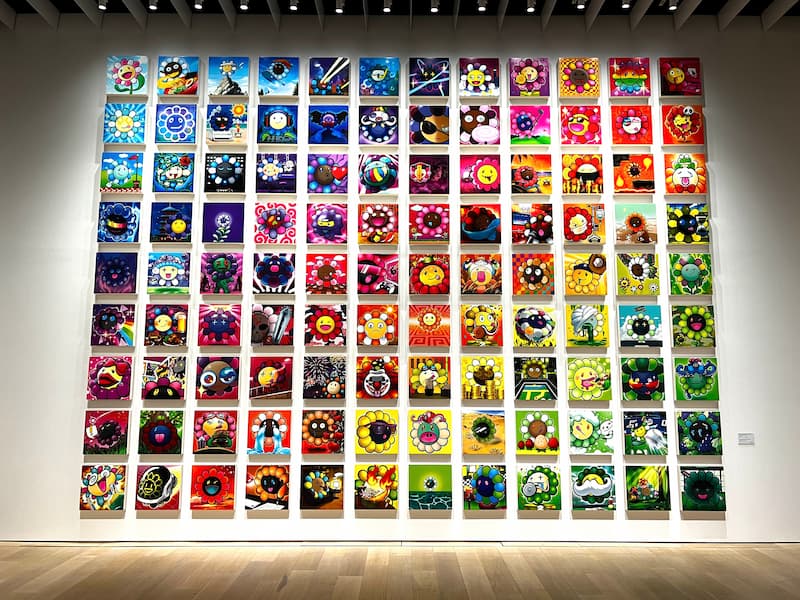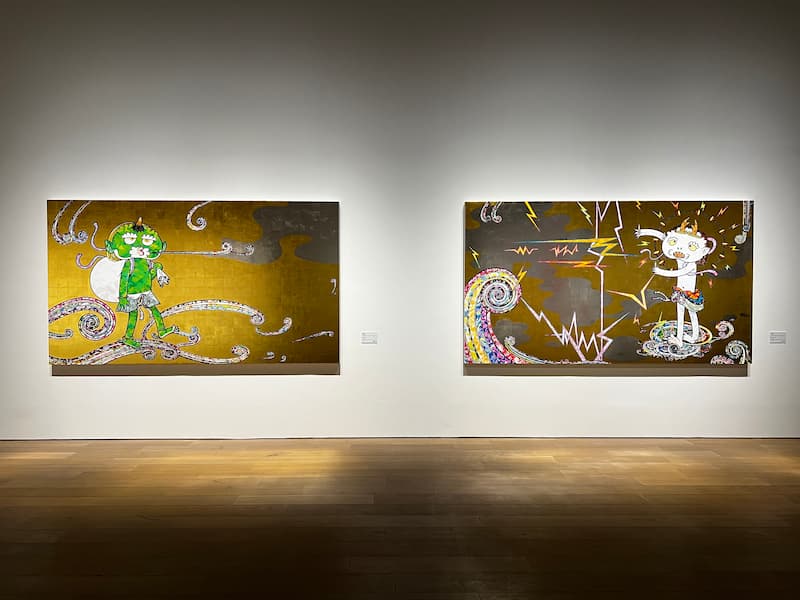Introduction
Takashi Murakami’s Mononoke Kyoto exhibition, staged at the Kyoto City Kyocera Museum of Art, is not just an art show; it’s a comprehensive narrative that merges the artist’s distinctive style with Kyoto’s rich cultural heritage. Marking the museum’s 90th anniversary, this exhibition is a significant milestone in Murakami’s illustrious career, offering a profound reflection on his connections to Kyoto—a city to which he moved with his family after the devastating Tohoku earthquake and tsunami in 2011.
A Fusion of Tradition and Innovation
Murakami’s Mononoke Kyoto is a vibrant tapestry of more than 170 artworks, many of which are new creations, showcasing his journey of integrating the ancient capital’s ethos into his contemporary practices. The exhibition reveals a unique work-in-progress format, where the display evolves over time, symbolizing the ongoing dialogue between the artist and the city’s historical and cultural narratives.
Reimagining Edo’s Masterpiece

At the heart of the exhibition lies a spectacular reinterpretation of the Edo period masterpiece, “Views in and Around Kyoto (Rakuchu Rakugai-zu Byobu),” originally by Matabei Iwasa. Murakami expands this historic canvas, magnifying its scale to an impressive 13 meters.

This piece beautifully encapsulates the essence of Kyoto, showcasing its landmarks and festivals, interwoven with Murakami’s iconic characters and motifs, creating a bridge between the Kyoto of yore and the city’s contemporary visage.
Superflat: A Cultural Critique

The “Mononoke Kyoto” exhibition serves as a platform for Murakami to delve deeper into his “superflat” concept—a philosophy that flattens the hierarchy between high and low art, advocating for a more inclusive approach to cultural production. This aesthetic is vividly demonstrated in pieces like “Superflat 2024,” challenging viewers to reconsider the notions of superficiality and depth in art and society. Murakami’s critique extends to Japan’s fascination with cuteness (kawaii), presenting it as a societal coping mechanism for historical traumas and contemporary issues.
Learn more about Superflat and the Takashi Murakami art style.
A Dialogue with the Divine

Murakami’s reinterpretations of traditional Japanese deities, such as the “Wind God” and “Thunder God,” offer a striking contrast to their historical depictions. By adopting a playful, less intimidating portrayal, these works comment on the changing perceptions of power and divinity in modern Japan, reflecting a society that gravitates towards gentleness and approachability over awe and fear.
Mononoke: Spirits of the Past and Present
The exhibition’s title, “Mononoke,” referring to vengeful spirits in Japanese folklore, hints at the underlying themes of conflict and coexistence between the old and the new. Murakami navigates this terrain by evoking the spirits of Kyoto’s past, inviting them into the present through his art. This fusion not only honors the city’s history but also critiques contemporary society’s struggles, showcasing Murakami’s art as a medium for historical reflection and societal commentary.
Personal Journeys and Artistic Evolution

“Mononoke Kyoto” is deeply personal, reflecting Murakami’s own experiences with relocating to Kyoto and his journey of finding a place within its cultural fabric. The exhibition stands as a testament to Murakami’s evolution as an artist, from his roots in traditional Japanese nihonga painting to his pioneering role in the “Superflat” movement and beyond. It highlights his ability to navigate and merge various artistic disciplines, contributing to a global understanding of Japanese art.
Kyoto Through Murakami’s Eyes
Murakami’s exhibition is not just an artistic endeavor; it’s a cultural dialogue with the city of Kyoto itself. By likening Kyoto to other historical cities like Rome, Murakami acknowledges the city’s rich heritage while critiquing its reluctance to embrace new cultural currents. Through “Mononoke Kyoto,” he invites viewers to see Kyoto through his eyes—a city of breathtaking beauty and deep historical significance, yet alive with the potential for new artistic expressions.

Conclusion
Takashi Murakami’s “Mononoke Kyoto” is a landmark exhibition that encapsulates the artist’s profound engagement with the cultural and historical essence of Kyoto. It stands as a vibrant testament to the possibilities of contemporary art to reinvigorate and reinterpret traditional themes for modern audiences. By weaving together elements of history, folklore, and personal narrative, Murakami presents a deeply resonant exploration of identity, culture, and artistry that bridges past and present, inviting viewers into a dynamic conversation with the spirit of Kyoto. Through September 1st, the Kyoto City KYOCERA Museum of Art hosts this remarkable journey, offering a glimpse into the heart of one of Japan’s most celebrated contemporary artists and the city that inspires him.
The Mononoke Kyoto Exhibition runs from 3rd February – 1st September, 2024 at the Kyoto City Kyocera Museum of Arts in Japan. Timings are from 10 AM to 6 PM daily (except Mondays and public holidays) with last admission at 5:30 PM. Tickets cost 2,200 Yen for adults with discounts for advance purchase and student tickets. Tickets can be purchased on the museum website.
Read more:
- Kamisaka Sekka: A Maestro of Ukiyo-e’s Evolving Canvas
- Yoshitomo Nara: Blending Ukiyo-e and Pop Culture in Japanese Art
- Tatsuro Kiuchi: The Japanese Illustrator Who Loves Old Things
- Yayoi Kusama: A Polka-Dotted Revolution in Art

At The Art of Zen we carry a selection of our own hand-crafted original Japanese art prints in the ukiyo-e and Japandi style. Some of our best selling work is Mount Fuji wall art and Japandi wall art.
Add some zen to your space with brilliant original art from the Art of Zen shop.




0 Comments